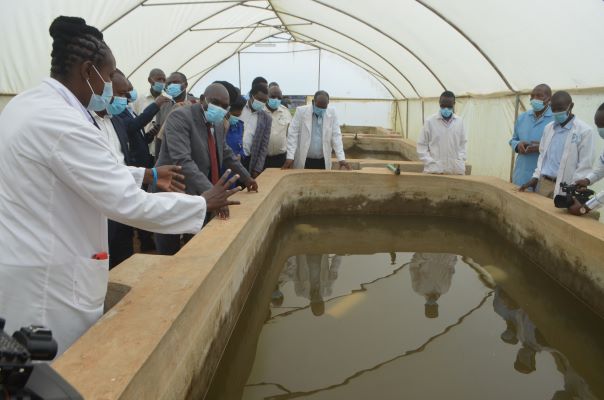By Zablon Oyugi
Commercial production of tilapia in Kenya has potential for expansion following the latest effort by the government to breed and introduce a new tilapia strain into the market.
The new breed, a farmed Nile tilapia or Oreochromis niloticus has been going through a series of development and trials by experts at Kenya Marine and Fisheries Research Institute’s (KMFRI) Sagana Centre.
“The selective breeding programme of this breed was initiated some years back, at the national aquaculture research and training Centre in Sagana and so far, we are at the eighth generation of breeding,” said Dr. Domitila Kyule, Sagana KMFRI Centre director.
According to the centre’s fish genetist, Jacob Abwao, the need for this new breed has been triggered by the ever increasing demand for tilapia fingerlings by farmers and tilapia fish by consumers.
“Currently, the demand is approximately 40 million fingerlings considering the investment in cage culture in Lake Victoria since the start of the implementation of the government stimulus program,” said Abwao.
On the other hand there’s a demand for 450,000 tonnes of fish in Kenya and there’s currently less than 35,000 tonnes produced by aquaculture. Around 50,000 tonnes of tilapia are currently imported from China, but consumers have a preference for local fish.
The stimulus program therefore prompted an immediate and short-term demand for about 28 million certified tilapia and catfish fingerlings.
Currently, there are close to 3,000 active cages in Lake Victoria producing an estimated 10,000 metric tonnes of fish annually.
The F8 generation through the Kenya climate smart Agriculture project and Climate smart Agricultural Productivity project has been validated at the on-farm level and also distributed to farmers in over 20 counties.
Benefits of the new breed
The a farmed Nile tilapia breed, according the researchers, has the following benefits to farmers:
- -a faster growth rate hence reduces harvest period hence farmers can harvest twice a year,
- -has a great resilience to drastic changes in the climate,
- -it is a good candidate for intensive aquaculture system considering it can be resistant to emerging diseases,
- -through this breed famers can increase the farm productivity with high turnover and
- -it is nutritious and with no side effects to the consumers.
Seed/fingerlings multiplication
In its 2021 State of Aquaculture in Kenya Report, KMFRI indicates that one of the problems affecting the industry is inadequate readily available quality fish seed (fingerlings) and in this, certified breeders or hatcheries have been allowed to multiply the new breed.
“Yes, we are encouraging certified hatcheries with the production capacity to get engaged in seed multiplication to meet the rising demand,” said Kyule adding that there is already a number of breeders in the country involved in the multiplication of the new breed of tilapia.
In this, the government recognizes the importance of hatcheries towards ensuring continued access to high-quality broodstock and seed.
As at 2017, KMFRI’s statistics indicate that there were 87 active hatcheries in the country of which 82 per cent are privately owned while the rest belongs to various government institutions.
Currently, Lake Victoria is suffering from overfishing, and tilapia, the most popular freshwater fish in Kenya, is becoming scarce increasing the demand for fingerlings.
This rise in demand for tilapia fingerlings is expected to continue due to the emerging cage farming n Lake Victoria which requires thousands of fingerlings.
This has pushed the current demand for tilapia fingerlings to approximately 40 million annually.
Where to get the new breed
According to Abwao, many hatcheries in Kenya are already having the farmed Nile tilapia breed for seed multiplication and sales to farmers.
“We, however, advise fish farmers to obtain fingerlings from authenticated hatcheries which have the recommended facilities for brooding for breed multiplication purposes,” he said.
The hatcheries recommended requirements include a water reservoir, resting tanks, breading tanks, weighing balance, incubators for hatching eggs, scoop nets, oxygen supply and fish packaging materials.
Generally, the recommended practice for the hatcheries in Kenya is to keep broodstock for three years before bringing in anew stock.
This is to ensure high fingerling production since females older than three years spawn less frequently.








